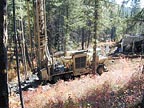
For instance: Do you fuel the rig on the way to the job or on the way back? If you stop to fuel on the way to the job, you have just increased your critical path time by 15 minutes to 20 minutes for no reason. If the rig left the yard full, you could save the time. Fuel up on the way in - it is something that needs to be done, but it doesn't interfere with drilling. It is a checklist item. Do it outside your critical path.
Drill water: Do you rig up and get everything ready before you start hauling water and mixing the mud? Chances are this is going to take a bit longer than hooking up a few hoses. So, if the longest (time-wise) thing you have to do is get up mud, start it first; you can do all that other stuff along the way. It shortens the critical path.
When drilling ahead, and it's time to make a connection, is the next joint doped? Picked up? Ready? It's a lot like a NASCAR pit stop - don't start looking around for the jack after the car is stopped!
When it's time to come out of the hole: Are the breakout tong dies sharp, or do they need to be changed? Are the tongs oiled? If you pump a slug, is it ready? Are the slips doped up? Do you stop in the middle of a trip to go hunt parts, or does your helper get a new pair of gloves? All of this interferes with the critical path.
Running casing: Is the string laid out, tallied, lugs welded on, whatever? Are the handling tools ready, or do you have to hunt them?
The point is: Focus on the objective - a completed hole. I've seen drillers pull out of the hole two joints shy of the casing point because it was lunch time, only to spend the rest of the afternoon reaming back to bottom, to get where they were at 11:45 a.m.
The ability to separate checklist items - things that have to be done, but not necessarily at a particular time - and critical path operations can make a significant difference in the total time spent drilling a well. While doing a task, a good driller generally is thinking of the next phase of the operation and preparing for it. I've seen oilfield companies actually graph this out in such a way that they can identify which parts of the operation contribute to overall time savings and which parts are time wasters. This is one reason the total completion time for well in the 'patch continues to go down. The bits still are drilling at about the same penetration rate, but the job is getting done sooner. This practice contributes directly to the bottom line and applies to us in the water well industry, too.
On a side note, just so y'all didn't think I was all technical and serious and stuff: We recently had the G8 Summit down here in Georgia. What a letdown. The authorities were all geared up for massive protests that never materialized. We had a reported 17,000 military and police in our little ol' county - and about 25 hippies. They blocked access to places, X-rayed all trucks, searched cars and generally made the place look just like occupied Baghdad. Dunkin' Donuts was safe … No trouble at all, except for a complete disruption of the ability to do business on the island.
I scheduled some work way out in the woods at the end of a dirt road, locked the yard and hunkered down. The only interesting thing I had happen was, one day I was on my way to town and noticed a long convoy of state troopers coming up behind me, headed for duty. I eased over to let them by. The road was a four-lane with a 45-mph speed limit, but these guys were running about 75 mph. I've always figured that it was pretty well acceptable to run with the flow of traffic, so when the last one passed by, I just naturally fell in with the “flow of traffic.” Took about 2 miles before one of the good-ole-boys fell in behind me and pulled me over. Wanted to know what I thought I was doing - “Going with the flow of traffic,” I informed him.
He wanted to know if I knew what the speed limit was. (I knew as well as he did - we all were ignoring it by mutual agreement!) I told him I figured it was kinda like a caution flag at Talladega - as long as you don't pass the pace car, you're OK. Heck, I wasn't passing! After being properly chastised, he let me go with a “Slow that thang down!”
ND






Report Abusive Comment